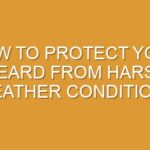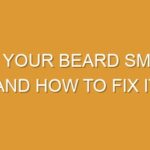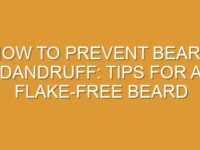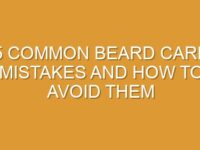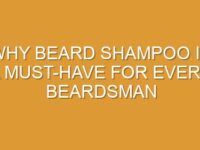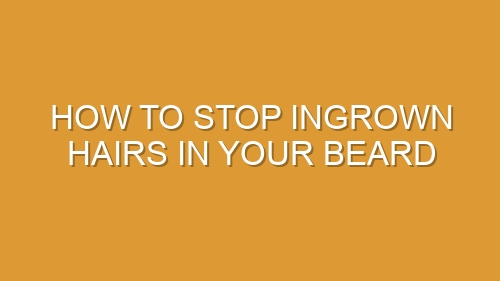-
Table of Contents
Understanding the Causes of Ingrown Hairs in Your Beard
Are you tired of dealing with pesky ingrown hairs in your beard? You’re not alone. Ingrown hairs can be a frustrating and uncomfortable problem for many men. But fear not, there are steps you can take to prevent and treat ingrown hairs in your beard. In this article, we will explore the causes of ingrown hairs in your beard and provide you with some helpful tips to stop them in their tracks.
Ingrown hairs occur when a hair curls back and grows into the skin instead of growing out of it. This can lead to redness, inflammation, and even infection. In the case of your beard, ingrown hairs are most commonly caused by improper shaving techniques. When you shave against the grain or pull the skin too tightly, you increase the likelihood of hairs becoming trapped beneath the surface.
Another common cause of ingrown hairs in your beard is dry skin. When your skin is dry, it becomes more prone to irritation and inflammation, making it easier for hairs to become trapped. Additionally, curly or coarse hair is more likely to become ingrown because it naturally has a tendency to curl back into the skin.
Now that we understand the causes of ingrown hairs in your beard, let’s discuss some strategies to prevent them. First and foremost, it’s important to adopt proper shaving techniques. Always shave in the direction of hair growth and avoid pulling the skin too tightly. This will help to minimize the risk of hairs becoming trapped beneath the surface.
In addition to proper shaving techniques, it’s crucial to keep your skin well-moisturized. Regularly applying a moisturizer or beard oil will help to keep your skin hydrated and prevent dryness. This will reduce the likelihood of irritation and inflammation, making it less likely for hairs to become ingrown.
Furthermore, exfoliating your skin regularly can also help to prevent ingrown hairs. By removing dead skin cells, you create a smoother surface for hairs to grow out of. You can use a gentle exfoliating scrub or a soft-bristled brush to achieve this. Just be sure not to scrub too harshly, as this can cause further irritation.
If you’re already dealing with ingrown hairs in your beard, there are a few steps you can take to treat them. First, resist the urge to pick or squeeze at the ingrown hair. This can lead to further irritation and potentially cause an infection. Instead, apply a warm compress to the affected area to help soften the skin and encourage the hair to come to the surface.
Once the hair has come to the surface, you can carefully use a pair of sterilized tweezers to gently lift it out. Be sure to disinfect the area before and after to prevent any potential infections. If the ingrown hair is particularly stubborn or causing significant discomfort, it may be best to consult a dermatologist for further treatment options.
In conclusion, ingrown hairs in your beard can be a frustrating problem, but with the right techniques, they can be prevented and treated. By adopting proper shaving techniques, keeping your skin moisturized, and regularly exfoliating, you can minimize the risk of ingrown hairs. And if you do find yourself dealing with an ingrown hair, remember to resist the urge to pick at it and instead opt for a warm compress and gentle extraction. With these tips in mind, you’ll be well on your way to a smoother, ingrown hair-free beard.
Effective Techniques for Preventing Ingrown Hairs in Your Beard
Are you tired of dealing with pesky ingrown hairs in your beard? Don’t worry, you’re not alone. Many men struggle with this common issue, but the good news is that there are effective techniques you can use to prevent ingrown hairs and keep your beard looking its best.
One of the most important steps in preventing ingrown hairs is to maintain a regular grooming routine. This means washing your beard regularly with a gentle cleanser and using a moisturizer to keep your skin hydrated. By keeping your beard and skin clean and moisturized, you can help prevent ingrown hairs from forming.
Another key technique for preventing ingrown hairs is to exfoliate your skin regularly. Exfoliation helps to remove dead skin cells and unclog pores, which can reduce the likelihood of ingrown hairs. You can exfoliate your skin by using a gentle scrub or a soft brush to massage your face in circular motions. Just be sure not to scrub too hard, as this can irritate your skin.
When it comes to shaving, there are a few techniques you can use to prevent ingrown hairs. First, make sure you’re using a sharp, clean razor. Dull blades can cause irritation and increase the risk of ingrown hairs. Additionally, always shave in the direction of hair growth to minimize the chances of hairs curling back into the skin.
If you prefer to trim your beard instead of shaving it completely, be sure to use a high-quality trimmer. Trimming your beard regularly can help prevent ingrown hairs by keeping the hairs at a consistent length. It’s also important to trim your beard in the direction of hair growth to avoid irritation.
In addition to these grooming techniques, there are a few other steps you can take to prevent ingrown hairs. First, avoid touching or picking at your beard too much. This can introduce bacteria to the area and increase the risk of ingrown hairs. Instead, try to keep your hands away from your face as much as possible.
It’s also important to avoid wearing tight-fitting clothing or accessories that can rub against your beard and cause irritation. Opt for looser clothing and avoid wearing scarves or hats that can rub against your beard and increase the risk of ingrown hairs.
If you do develop an ingrown hair, it’s important not to pick at it. Instead, gently exfoliate the area and apply a warm compress to help reduce inflammation. If the ingrown hair doesn’t improve or becomes infected, it’s best to see a dermatologist for further treatment.
In conclusion, preventing ingrown hairs in your beard is all about maintaining a regular grooming routine and using the right techniques. By keeping your beard and skin clean, moisturized, and exfoliated, you can reduce the likelihood of ingrown hairs. Additionally, using sharp, clean razors and trimming your beard in the direction of hair growth can help prevent ingrown hairs when shaving or trimming. Remember to avoid touching or picking at your beard too much and to wear loose-fitting clothing to minimize irritation. By following these tips, you can keep your beard looking its best and say goodbye to ingrown hairs for good.
Natural Remedies and Products to Treat and Eliminate Ingrown Hairs in Your Beard
Are you tired of dealing with pesky ingrown hairs in your beard? Don’t worry, you’re not alone. Ingrown hairs can be a common problem for many men, but the good news is that there are natural remedies and products available to help treat and eliminate them. In this article, we will explore some of the best ways to stop ingrown hairs in your beard, so you can enjoy a smooth and irritation-free face.
One of the most effective natural remedies for ingrown hairs is exfoliation. By gently scrubbing your beard with a natural exfoliating product, you can remove dead skin cells and unclog hair follicles, preventing ingrown hairs from forming. Look for products that contain ingredients like sugar or salt, as these can help to slough off dead skin cells without causing irritation. You can also make your own exfoliating scrub at home by mixing sugar or salt with a carrier oil, such as coconut or olive oil.
Another natural remedy for ingrown hairs is tea tree oil. This essential oil has antibacterial and anti-inflammatory properties, making it a great option for treating and preventing ingrown hairs. Simply apply a few drops of tea tree oil to a cotton ball and dab it onto the affected area. Be sure to dilute the tea tree oil with a carrier oil, as it can be quite potent on its own. Repeat this process twice a day until the ingrown hair has healed.
If you prefer to use a product specifically designed to treat ingrown hairs, there are several options available on the market. Look for products that contain ingredients like salicylic acid or glycolic acid, as these can help to exfoliate the skin and prevent ingrown hairs from forming. You can also find products that contain soothing ingredients like aloe vera or chamomile, which can help to reduce inflammation and irritation.
In addition to using natural remedies and products, there are a few other steps you can take to prevent ingrown hairs in your beard. First, make sure you are using a sharp razor when shaving. Dull blades can cause the hair to be cut unevenly, increasing the likelihood of ingrown hairs. It’s also important to shave in the direction of hair growth, as shaving against the grain can cause the hair to curl back into the skin.
Another tip is to avoid shaving too closely to the skin. Leaving a bit of stubble can help to prevent ingrown hairs from forming. If you prefer a clean-shaven look, consider using an electric razor instead of a traditional blade. Electric razors are designed to cut the hair above the skin, reducing the risk of ingrown hairs.
Finally, be sure to moisturize your beard regularly. Dry skin can contribute to ingrown hairs, so it’s important to keep your skin hydrated. Look for a moisturizer that is specifically formulated for the face and beard, as these products are designed to nourish the skin without clogging the pores.
In conclusion, ingrown hairs in your beard can be a frustrating problem, but there are natural remedies and products available to help treat and eliminate them. By exfoliating regularly, using tea tree oil or other ingrown hair treatments, and taking preventative measures when shaving, you can say goodbye to ingrown hairs and hello to a smooth and irritation-free beard. So why wait? Start incorporating these tips into your grooming routine today and enjoy a beard that looks and feels its best.

